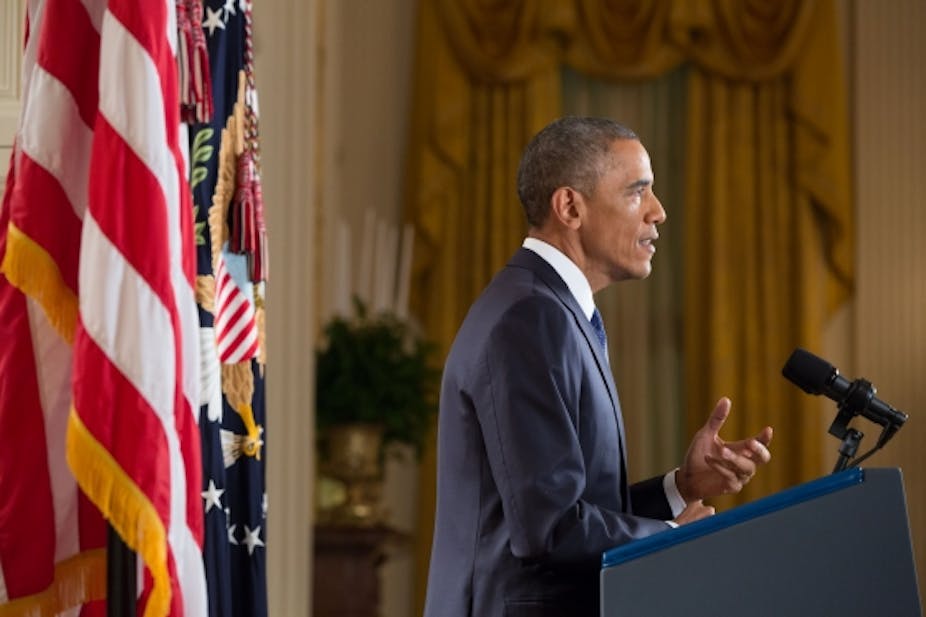There has been a tremendous amount of controversy surrounding President Barack Obama’s November 20 executive order concerning the implementation of the 1952 Immigration and Nationality Act (as amended).
The centerpiece of President Obama’s order is to prioritize the enforcement of the law and halt the deportation of close to five million undocumented aliens living in the United States. On balance, I believe President Obama acted within his authority. There is plenty of precedent for issuing executive orders, but it is by no means an open and shut case.
Executive orders: the historical context
Under the US Constitution the president is designated the chief executive of the federal government. As chief executive, the president has the primary responsibility for executing the law. In writing the law Congress cannot anticipate all of the conditions under which it is enforced. Consequently the legislative branch must allow the executive branch a certain amount of latitude in the execution of the law. Thus, presidents take administrative actions including executive orders to carry out their responsibilities.
The authority of presidents to issue executive orders is recognized in the courts and is as old as the republic itself. For example, in what is regarded as the first example of an executive order, President George Washington in 1789 ordered Federal department heads “to submit[to the President] ‘a clear account’ of affairs connected with their departments.”
President Obama has not been particularly prolific in issuing executive orders compared to other modern presidents. The president has averaged 33 executive orders per year as compared to George W. Bush (36), Bill Clinton (46), and Ronald Reagan (48). But those numbers can be misleading. One executive order is not like another. The federal government controls almost 25% of the gross national product, employs about four million people (including the military), and it can summon the most powerful military force on earth. To have control over that organization gives the president tremendous power indeed.
Is President Obama’s executive order legal?
In general the courts apply a “tripartite” test to the legality of executive orders. This test originates in Justice Robert Jackson’s opinion in the 1952 Steel Seizure case.
In that case the Court ruled on the constitutionality of President Truman’s decision to seize parts of the American Steel industry to avoid a labor strike during the Korean War.
In voting to overturn Truman’s action, Justice Robert H. Jackson ruled that an executive order is constitutional if it is based on statutory authority granted to the president by Congress and/or if the executive order complies with meaning and intent of the law, and/or the executive order is justified within the context of the President’s constitutional powers. The Court overruled Truman’s actions, but the Youngstown case is an exception to the rule, the Courts are generally quite lenient towards the exercise of presidential power as Chief Executive.
Current Justices Samuel Alito and John Roberts have both favorably cited Jackson’s opinion to defend a rather expansive view of presidential power in this regard.
In the case of President Obama’s order on immigration, he will be arguing that his executive order meets the second test.
The particularities of immigration law
Immigration law tends to prioritize the detention and deportation of illegal immigrants with criminal records. The problem is that Congress has failed to amend the law to give the president more explicit instructions and has failed to provide the president with sufficient resources to deport all undocumented aliens who, in the technical sense, are all law breakers. Thus, Obama is going to argue that given the original intent of the law and given the scarcity of resources, he is simply following the spirit of the law by prioritizing enforcement.
However, the way he has written the executive order, it appears that he may have amended an existing law without congressional involvement and that he cannot do. The centerpiece of the President’s order are amendments to the DACA (Deferred Action for Children Arrivals) Program. DACA was a program adopted by the U.S. Customs and Border Protection (CBP), US Citizenship and Immigration Services (USCIS), and US Immigration and Customs Enforcement (ICE) (pursuant to a presidential directive) in 2012 in response to Congress’ failure to pass the DREAM Act (a pathway to citizenship). Congress tried to defund DACA but failed. It will try so again in the next Congress and it will fail again because of the filibuster in the Senate and, ultimately, the President’s veto. Thus, this issue will probably end up in the courts.
The President will argue that through DACA and other programs he is simply prioritizing enforcement of the law along the lines of the statute’s original intent. Prioritizing enforcement is clearly within the president’s executive power. Those who oppose the president will argue that the president is creating statutory authority with no legal basis. They will argue that the original law was intended to target all illegal immigrants and that there are sufficient resources for the president to carry out that task. Both arguments, particularly the second, are a stretch but given the close political split on the Supreme Court, it is never completely clear what the Court will do.
The fact is that there is ample precedent for what the President is trying to do. The President can with good reason prioritize enforcement of the law. However, the President may have overreached by formalizing the arrangement which gives the appearance of creating law. Nevertheless, he has a good case to make on its merits and the courts will probably allow him to do what he is going to do.

